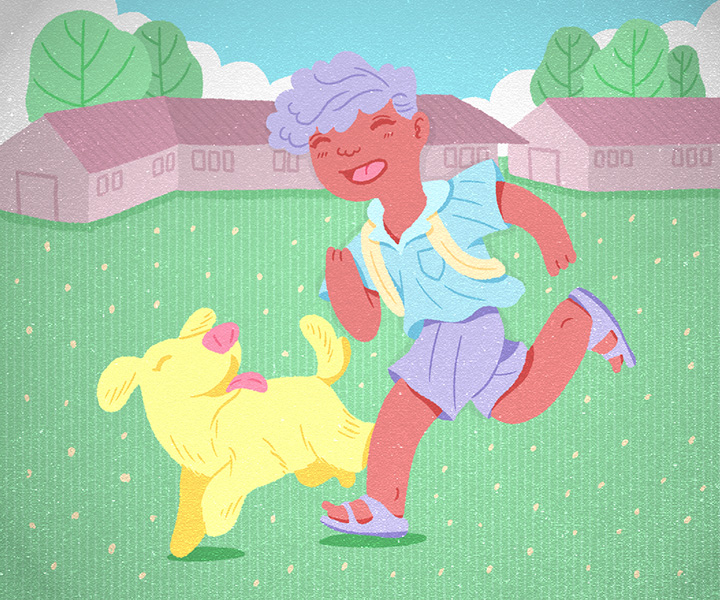Trigger warning: Harm to self and others.
Classrooms are a space for tamariki to learn and grow, and a space for educators to create nurturing environments that are inclusive for neurodiverse tamariki and students who live with mental health conditions. This series focusing on inclusive education hopes to contribute to the discourse while acknowledging the important role our educators hold in supporting all ākonga on their journey.
Everyone experiences occasional intrusive thoughts – involuntary and unpleasant ideas, images and urges that ‘pop up’ in our minds. It’s also common for people to have little mantras and habits that they choose to do and find comforting. However, in obsessive compulsive disorder (OCD), an intrusive thought gets ‘stuck’, returns again and again, and causes psychological distress. Doubts and worries about an obsessive thought commonly cause a person to experience considerable anxiety and fear that can only be resolved by completing a specific mental or physical action (compulsion) to provide momentary relief. As relief from this mental distress is obtained by completing the compulsion, the obsessive-compulsive loop becomes reinforced in the mind, making it harder to resist the next time.
Obsessive-compulsive symptoms are often first experienced during childhood and adolescence and tend to wax and wane in severity throughout life. In New Zealand, results from the Dunedin longitudinal study have revealed that it was quite common for children to have obsessive-compulsive symptoms and, as adults, in any given year from 2 to 6% of study participants have met the threshold for OCD itself.
OCD is much more than its stereotypes of being extremely neat or tidy. It’s a mental health condition that includes a range of behaviours that result from a person trying to soothe or prevent their anxieties. Unfortunately, OCD can often be misunderstood as reluctance, procrastination, or resistance towards a task. Jokes about everyone being ‘a little OCD,’ don’t help either. It is a complex health issue that requires formal diagnosis and structured therapy.
A teacher’s perspective – Laura Butler
Laura Butler is a teacher and had OCD since she was a child but wasn’t diagnosed until she was an adult. As a primary school teacher, she’s taught in Auckland, Greymouth and Hastings. Laura credits the inclusive and non-judgmental culture for kaimahi and students at Te Kura in Heretaunga for creating a safe place of mahi and learning. It was there that Laura realised how much anxiety can affect ākonga and staff.
Laura shares her reflections below:
“In teachers’ college, people made comments about how ‘OCD must make you a good teacher’ because they perceived me as being organised and detail oriented. What people don’t understand is that those ‘skills’ are my attempts to control my environment to minimise the harm I think I cause others. As an adult, I’ve learned that going around sorting and organising can be a sign I’m getting sick — it makes me a good teacher in the same way someone sneezing would. So, it’s an odd thing to comment on.
I have harm OCD. For me, I get thoughts that I have blacked out, harmed someone, and they are currently hurting. This makes me want to go and check on them. But ten minutes after I do that, I think ‘maybe in the last ten minutes I blacked out and hurt them’ and on it goes. I’ve come to understand that I’m not actually going to hurt people but as a 7-year-old, checking on my teacher at lunch to make sure they were okay, I didn’t know that. They were just annoyed I was disturbing them, which as a teacher now, I can totally understand. But I still wonder if they could have been more empathetic? Maybe? Someone with OCD can be tricky to interact with when you don’t know they are fighting obsessive thoughts, and even when you do, it can still be difficult.
Eventually, after taking 70 ‘sick’ days in one year, I stopped going to school and enrolled in Te Kura. I became the truancy statistic that gets bandied about in the media. When kids talk about being too anxious to go to school, we need to listen to them.
In high school, I would constantly unpack and repack my bag, making sure I hadn’t blacked out and brought something harmful to school, but this was seen by the school as work avoidance. Eventually, after taking 70 ‘sick’ days in one year, I stopped going to school and enrolled in Te Kura. I became the truancy statistic that gets bandied about in the media. When kids talk about being too anxious to go to school, we need to listen to them. It’s not just a silly excuse because I was weighing up my education with the perceived risk that people would be hurt or die. I often reflect on how I react to the student who comes to ‘check on me’ when I’m trying to prepare for a lesson and eat some lunch, or the child who seems distracted by something other than the learning task before them. Am I doing any better for them than what was done for me?
It’s important that my students see me as a human – as a mother, a member of a sports team, an adventurer, and a good friend. So why not also as someone who lives with OCD?
There are professional conversations that are awkward and difficult and need to be had by all those in education. We are being asked to paper over a lot of cracks in society. There are students with complex needs and low coping strategies, but a lack of psychologists to diagnose and treat the mental health of our rangatahi. How can we support ākonga who battle intrusive thoughts with empathy, while still caring for ourselves enough to take a lunch break? We’re also trying to educate a society of parents that still equate suggestions that their child is struggling with mental health as an attack on the child’s resilience or intelligence. We have a role to play in this, but it is narrower than the one we are being expected to fill right now. It’s exhausting, but more so for staff who have the diagnoses and know the pain themselves. Sometimes as a teacher, I feel like I must model ‘perfect’, and OCD doesn’t fit into that. But I also know it’s important that my students see me as a human – as a mother, a member of a sports team, an adventurer, and a good friend. So why not also as someone who lives with OCD?”
Understanding OCD
Dr Sarah Watson (Totally Psyched) is a Senior Clinical Psychologist based in Tāmaki Makaurau. Her team regularly support children and teenagers with OCD. Watson says it’s important to hold empathy, even if the fears and actions may seem illogical to someone who hasn’t experienced OCD.
While someone might have the best intentions, they should never tell someone with OCD to not do a behaviour, as the anxiety is often very distressing and following the compulsions often feels out of their control, says Watson. “A lot of people who don’t understand the severity of the anxiety dismiss these fears. But if someone with OCD could, they would.”
“OCD can be a cruel jailer, capturing a child’s desire to be normal, but making them do things they don’t want to on one level, but need to on another,” says Watson. The anxiety from not following the OCD rules can be debilitating and feel impossible to tolerate without help or support. “It is not fair or kind, by any means, and can rob kids of time, joy and confidence.”
It’s important to hold empathy, even if the fears and actions may seem illogical to someone who hasn’t experienced OCD.
She has noticed OCD impacting tamariki as young as five years old. “The most common time overt symptoms are noticed tend to be around ten years old, coinciding with the developmental stage when kids begin to understand the potential permanence of harm and that there are external elements that can make us vulnerable and are out of control.”
Fear of harm to oneself or their loved ones is the most prevalent theme of obsessions. For example, natural disasters or the potential of germs that cause them and their loved ones to get sick. “It’s also the age children begin to understand that death is permanent. So that can create a lot of fear.”
Watson explains that hand washing is often the first form of ritualising young people experience and a way for the mind to try to feel more control or decrease their fears. However, this is only one way that OCD can manifest. “It’s not an easy assessment, and there’s lots of misinformation in the media,” Watson says. “One child’s OCD can be vastly different to someone else’s. In a classroom, this might look like slow or incomplete work due to the pressure of having to rewrite a line twenty to thirty times before it feels right and before the next line can be attempted; flicking through open tabs on the computer 40, 60, 80 times before being able to feel they achieved the right number of times and can just get started; having to throw away school work because someone or something touched/contaminated it, to name a few.”
Some students experiencing OCD can feel immense pressure and stress in their journey to school, for example: “they have to make sure they walk up stairways, so their left leg is symmetrical with their right leg on each step, or doing the same around cracks in the concrete,” says Watson. “Goodness knows the stress it induces if they do not align or feel right, least it all has to be repeated again, sometimes 20-30 times.”
Challenges in the Classroom
Dylan*, a New Zealand student, and his mother Jo want to share his experience to help others understand OCD. Jo says that Dylan was well-behaved at primary school and was doing fine academically. His parents knew that he was anxious but found that there wasn’t a clear pathway to access early intervention.
Dylan remembers that he had lots of worries about lots of things. “I needed to check things to make me feel better. I checked if there were any cobwebs or spiders in the room. Then I had to check if the doors and drawers in my room were shut.”
“I didn’t like hearing the swearing and things like that from the older kids. If the teacher told the whole class off for something, I always felt bad even if it wasn’t me. I tried to do the right thing all the time. I thought the bad things were making me bad. I didn’t like other kids touching me or my things. When I got home, I had to clean myself so much because I felt so bad.”
After Covid lockdown, there was sanitiser everywhere at school, and Dylan used it all the time to clean his hands when he felt worried. The family’s GP said it was likely to be OCD and referred them to a general mental health service.
It’s important that treatment be specifically tailored to OCD, rather than other forms of anxiety. It wasn’t until the family accessed specialist mental health services that they started getting the right kind of support for Dylan.
The work Watson does includes exposure and response prevention (ERP) therapy, a structured process designed to provide the young person with confidence and skills to decrease and challenge OCD behaviour and emotions. “A lot of people fear the therapy, because they think they will be made to do things that are too distressing. However, it’s quite the opposite. At no point would a young person be required to do anything that is highly distressing.”
Learning Environments
Calm, structured, predictable, and quiet classroom environments are particularly helpful for neurodiverse tamariki and students living with mental health conditions like OCD. A collaborative approach with parents and caregivers to figure out strategies to help the student will provide better outcomes, like demonstrating confidence and belief that the child is capable of learning to manage their challenges.
Dylan had stopped going to school, but after OCD-specific therapy he started attending student support classes. “They had a dog there. I took the dog for walks whenever I felt worried. I started to look forward to seeing the dog. I think all schools should have dogs!”
After a year, Dylan was able to be in the classroom for the entire day. Now he’s back in mainstream classes and feels more confident going to school. “It’s easier when I have good friends in my class that I can joke with. In some classes I have no friends and then my worries get worse.”
“I still get lots of worries and I still need to clean when I get home. I don’t want my mum and dad to go into school because then they will get dirty, so they have to do all their meetings with teachers by Zoom.”
As with any student with difficulties, building trusting, safe relationships is key, says Jo. “The therapy for OCD is about doing the things that give you discomfort and discovering that you can manage, so having a secure, safe base that allows the students to try hard things is crucial.”
Because Dylan is on high alert during his time at school, it can be easy for him to become overwhelmed, says Jo. “Maintaining a calm classroom, while adding laughter and fun to lessons helps bring Dylan’s stress levels down so he can better manage his day. We appreciate the work the pastoral care team put in to ensure that his class placement included trusted friends and calm classroom environments.”
Watson considers the number of kids who feel ashamed about their OCD heartbreaking. Tamariki and rangatahi often try to cover up OCD behaviour so as not to appear ‘weird’ to their peers, she says. They often hold fears of embarrassing themselves and desire to appear ‘normal’ to others.
Because of the complex and varied nature of OCD, Watson emphasises the importance of leaving the diagnosing to psychologists or psychiatrists. However, if educators notice behaviours that seem obsessive or compulsive, they can help by having discrete, private, and non-judgemental conversations with the child and their family about the things that might impact them. “A child, even if they are young, is generally able to articulate what is going on for them.”
“OCD is one of those things that if it hasn’t resolved in 3-6 months, then it’s likely to continue. It often gets worse if left untreated and can extend across the lifetime. Anxiety is it’s primary root cause, and so OCD is likely to get worse in a stressful environment. And vice versa, if the environment is happy and chill, then OCD behaviours can decrease.”
However, Watson holds hope and emphasises that most kids and young people with OCD are brave and resilient. “They have to deal with so much, and once they have garnered the skills and insight that OCD therapy can give, they are often stronger than ever before!”
Further information
This article was created in partnership with Fixate, a Facebook-based community for people in Aotearoa New Zealand living with OCD or supporting someone living with OCD. Marion Maw, an Admin of Fixate, helped to co-ordinate the contributions and to shape the piece. If you would like to learn more about OCD, please visit ocd.org.nz or email ocd.org.nz@gmail.com. The book, ‘Talking back to OCD’ by John S Marsh and Christine M Benton is also a helpful resource for parents and teachers to support tamariki with OCD.
*name changed for privacy





